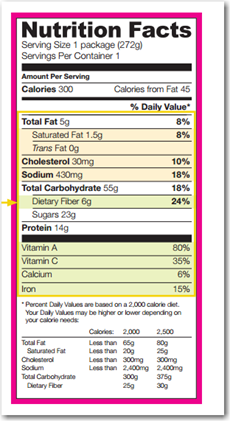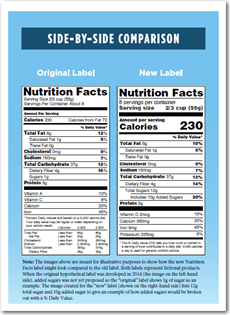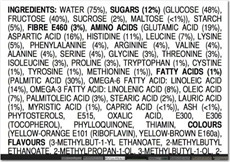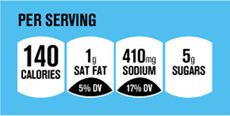
Sugars: A Scientific Overview
There are myths, fads, and misconceptions associated with various aspects of our food supply, such as food additives and ingredients. Concerns and questions about sugars (caloric sweeteners) in foods have arisen. This document presents information that IFT hopes will demystify the role of sugars in foods and the nature of sugars in the diet.
What are sugars?
Sugars are a type of carbohydrate, and as with other carbohydrates they contain carbon, hydrogen and oxygen molecules. Carbohydrates, are an important part of a healthy diet, as are proteins and fats. Except for dietary fiber, when carbohydrates are consumed they are digested and broken down into glucose, which serves as an energy source for most tissues in the human body. Glucose is a preferred source of energy for red blood cells, the central nervous system, and the brain. Except for dietary fiber, carbohydrates provide approximately 4 calories per gram.
Sugars are caloric, sweet-tasting compounds that occur widely in nature, including fruits, vegetables, honey, and human and dairy milk. Humans are born with the desire or preference for sweet taste. The presence of lactose (a type of naturally occurring sugar in milk) in breast milk helps ensure that this primary source of nutrition for infants is palatable and acceptable. Chemically and with respect to foods, sugars are monosaccharide or disaccharide carbohydrates, which impart sweet taste. Most foods contain some of each.
Monosaccharide: A single molecular unit which is absorbed directly into the blood stream. The most common monosaccharides are glucose (also known as dextrose), fructose, galactose and mannose.
Disaccharide: Sugar containing two monosaccharides linked together which are broken down in the body into two single sugars. The most common disaccharides are:
- Sucrose (or table sugar) = glucose + fructose
- Lactose = glucose +galactose
- Maltose = glucose + glucose
- Trehalose = glucose + glucose, but the two units of glucose are linked differently than maltose
Sugars vary in their sweetness intensity, ranging from the relatively low sweetness of lactose, to the considerably greater sweetness of fructose, the sweetest of the naturally-occurring sugars.
Do Sugars occur naturally?
Yes, sugars (mono- and disaccharides) occur naturally in foods such as fruits, vegetables, milk, and honey. For example, glucose occurs in corn, honey and fruits; fructose (fruit sugar, or levulose) is found in honey and fruits; sucrose is found in sugar cane, sugar beets, fruits, and vegetables; lactose occurs only in milk; maltose is found in molasses; trehalose is found in mushrooms; and galactose only occurs in foods in a form in which it is bound to glucose as lactose.
Are Sugars produced commercially?
Yes, sugars are produced commercially. For example, sucrose (table sugar) is produced from sugar cane and sugar beets; brown sugar, molasses, and cane sugar are produced from sugar cane; and corn syrup and high-fructose corn syrup are produced from corn starch. Other sources of sugar include maple syrup, malt syrup, agave syrup, and fruit juice concentrates.
What are added sugars?
The Dietary Guidelines for Americans 2015-2020 describes added sugars as syrups and other caloric sweeteners that are added to foods and beverages to sweeten them. However, for the purpose of labeling added sugars on the Nutrition Facts label, the U.S. Food and Drug Administration (FDA), has developed a more elaborate technical definition. As defined by the FDA, added sugars “are either added during the processing of foods, or are packaged as such, and include sugars (free, mono- and disaccharides), sugars from syrups and honey, and sugars from concentrated fruit or vegetable juices that are in excess of what would be expected from the same volume of 100 percent fruit or vegetable juice of the same type.” The definition does not include fruit or vegetable juice concentrated from 100 percent juice that is sold to consumers, fruit juice concentrates which are used to formulate the fruit component of jellies, jams, or preserves, or the fruit component of fruit spreads.
Why is sugar added to foods?
Sugars are added to foods because they provide many important functions in foods. In addition to imparting sweetness, sugars are added to food and beverage products to contribute to color and flavor development (in baked goods and meats, through browning, for example); provide body, bulk, or volume (such as in baked goods, preserves, and jams); and contribute to texture (such as creaminess of frozen desserts, syrup, and candies; or tenderizing lightness in bakery products). Sugars may interact beneficially with other food ingredients, enhancing flavor profile (acting synergistically to increase the aroma of a flavor, for example) or balancing bitterness (such as that of cocoa in chocolates). Sugars may be used to control freezing point and crystallization in ice cream, or boiling point in candy making. They may be used for microbial fermentation, to produce foods such as pickles and yeast-leavened bread. Sugars may also be used to prevent the growth of microorganisms, by binding water and making it less available for microbial growth, thereby preserving foods by controlling spoilage (such as in jams and jellies). Examples of foods and beverages that contain added sugars include sugar-sweetened beverages, dairy and grain-based desserts, and sweet snacks.
Do naturally-occurring sugars provide a different amount of calories than commercially-produced sugars?
No, naturally-occurring sugars do not have a different caloric value than commercially-produced sugars. Regardless of their source (naturally-occurring or commercially produced), when sugars are metabolized they provide about 4 calories per gram—the same amount of calories as other carbohydrates (except dietary fiber) and protein.
Is there a recommendation on sugar intake?
The evidence for added sugars and health outcomes is still developing. However, there is strong evidence suggesting that eating patterns which include low intake of added sugars are associated with reduced risk of cardiovascular disease in adults; and there is moderate evidence that these eating patterns are associated with reduced risk of obesity, type 2 diabetes, and some types of cancer in adults. Further, there is moderate evidence of a relationship between added sugars and dental caries in children and adults.
Currently, Americans on an average consume 270 calories per day (more than 13% of total calories) from added sugars, with intakes particularly high among children, adolescents, and young adults. The Dietary Guidelines for Americans 2015-2020 recommends consumption of less than 10% of calories per day from added sugars, to help people achieve a healthy eating pattern. A healthy eating pattern helps people limit consumption of added sugars, meet nutrient and food group needs through nutrient-dense foods and beverages, and stay within calorie limits.
The Dietary Guidelines for Americans 2015-2020 recommends consumption of less than 10% of calories per day from added sugars, to help people achieve a healthy eating pattern.
To help achieve the recommendations on added sugars, the Dietary Guidelines suggest, for example:
- Reducing portions of sugar-sweetened beverages, drinking these beverages less often, and choosing beverages low in added sugars
- Choosing beverages with no added sugars
- Limiting or decreasing portion size of grain and dairy-based desserts and sweet snacks
- Choosing unsweetened or no-added-sugar forms of canned fruits, fruit sauce, etc.
While reading nutrition labels or adding sugar to foods and beverages, keep in mind:
1 gram of sugar provides about 4 calories
4 grams of sugar = 1 teaspoon
Replacing added sugars with high-intensity sweeteners as low- or no-calorie options for sweetening foods and beverages may help in reducing caloric intake.
Where can I find information about sugars in foods and beverages?
Information on sugars in packaged food and beverage products is available on:
Nutrition Facts Label: The phrase “Sugars” listed on the current Nutrition Facts label represents both naturally-occurring and added sugars and shows the amount (in grams) of sugar in one serving of the food.
Example of the Current Nutrition Facts Label:
The new rules for Nutrition Facts label require food manufacturers to list the amount (in grams) of “Added Sugars” (sugar added to the food during food production), in addition to the “Total Sugars” (which includes naturally-occurring and added sugars) in one serving of the food. Food manufacturers with annual food sales of $10 million or more are required to have the new Nutrition Facts label on food and beverage packages by January 1, 2020. Manufacturers with less than $10 million in annual food sales must comply by January 1, 2021.
Example of the New Nutrition Facts Label:
Ingredient List: The sugars added to foods and beverages are listed in the ingredient list. The ingredients are listed in descending order based on the amount – which means that the closer they are at the beginning of the list, the higher the amount of that ingredient in the food. Examples of added sugars that may be listed as an ingredient include brown sugar, corn sweetener, corn syrup, dextrose, fructose, glucose, high-fructose corn syrup, honey, invert sugar, lactose, malt syrup, maltose, molasses, raw sugar, sucrose, trehalose, turbinado sugar, anhydrous dextrose, confectioner's powdered sugar, corn syrup solids, maple syrup, nectars (e.g., peach nectar, pear nectar), sucrose, sugar, and white granulated sugar.
Example of Ingredient List:
Front of Pack Label: Some packaged foods may also identify the presence of sugars on the front of the package. However, the amount of sugars represents both naturally-occurring and added sugars.Example of Front of Pack Label:
References
CDC. Know your limit for added sugars.
FDA. Nutrition labeling of food. 2016.
FDA. Sugars: what they are.
HHS/USDA. 2015. Dietary Guidelines for Americans 2015-2020.
Horn L, Johnson R, Flickinger B, Vafiadis D, Yin-Piazza S. 2010. Translation and implementation of added sugars consumption recommendations: a conference report from the American Heart Association added sugars conference 201. Circulation 122:2470-2490.
Sanders L, Lupton J. 2006. Carbohydrates. In: Bowman B, Russell R, editors. Present knowledge in nutrition. Ninth edition, volume I. Washington, DC: ILSI Press. p 78-88.
Sigman-Grant M, Morita J. 2003. Defining and interpreting intakes of sugars. Am J Clin Nutr 78:815S-26S.
Spillane WJ. 2006. Optimizing sweet taste in foods. Boca Raton, FL: CRC Press. 415 p.
USDA. What are added sugars?
Vaclavik V, Christian E. 2014. Carbohydrates in food. In: Heldman D, editor. Essentials of food science. 4th edition. New York, NY: Springer. p 27-37.
Vaclavik V, Christian E. 2014. Sugars, sweeteners. In: Heldman D, editor. Essentials of food science. 4th edition. New York, NY: Springer. p 279-295.
Varzakas S, Labropoulos A, Anestis S. 2012. Sweeteners. Nutritional aspects, applications, and production technology. Boca Raton, FL: CRC Press. 437 p.
IFTNEXT

Episode 28: Spicing Up the Future of Food
In this podcast we’ll focus on some of nature’s herbs, spices and the extracts that offer potential health benefits. We'll also talk with the article's author, Linda Ohr, about what the research tells us, as well as some entrepreneurial companies who have tapped these spices' hidden potential for their current and future product innovation.




